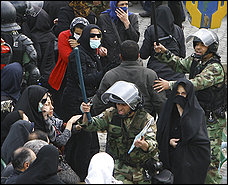In Iran, rival rallies show rift endures
Clashes erupt as regime marks 30th anniversary of U.S. Embassy siege
Thursday, November 5, 2009
TEHRAN -- Thousands of Iranians took to the streets Wednesday to mark the 30th anniversary of the 1979 seizure of the U.S. Embassy in Tehran, but the annual state-sponsored anti-American rally turned into another sign of the deep divisions persisting in this country.
As pro-government demonstrators ritually chanted "Death to America!" outside the former U.S. Embassy, opposition protesters used the occasion to vent their anger over a disputed presidential election in June and the harsh crackdown on subsequent protests. Converging on a square about half a mile from the former embassy, the opposition marchers denounced President Mahmoud Ahmadinejad with shouts of "Death to the dictator!"
The rival demonstrations -- and ensuing street clashes between protesters and security forces -- illustrated the split that has come to define Iran three decades after Islamic revolutionaries overthrew the U.S.-backed shah and branded America "the Great Satan." While Iran's ruling ayatollahs and government leaders maintain their entrenched distrust of and enmity toward the United States, the young people who form the bulk of Iran's population have no memory of those revolutionary days, and many opposition supporters favor a more open society and greater international engagement.
The government has struggled to quell protests for five months, deploying security forces on the streets of Tehran and officially banning opposition demonstrations. Yet, on Wednesday, anti-government demonstrators openly defied the ban, even as police fired tear gas and warning shots. In video clips captured by cellphone cameras, helmeted police officers could be seen beating protesters, including women, with batons.
In Washington, before the clashes broke out, President Obama issued a statement marking the anniversary of the embassy takeover, in which militants stormed the building and seized diplomats and other U.S. personnel, whom they held hostage for 444 days. Obama called on the Iranian government to decide whether it wants to focus on the past or the future.
"Iran must choose," he said.
Clashes were reported Wednesday in several places in Tehran and in Shiraz, a city 420 miles south of the capital. Most demonstrators were unable to convene for long periods, as motorcycle units of the Revolutionary Guard Corps and members of a pro-government militia arrived to disperse them.
Security forces prevented opposition leader Mir Hossein Mousavi, a former prime minister who challenged Ahmadinejad in the June 12 election, from leaving his office, a Web site affiliated with Mousavi reported. "He was under de facto house arrest today from the early morning," another Web site said.
The anti-government demonstrations, planned for weeks via the Internet, graffiti messages and illegal leaflets, were smaller than similar protests staged in September during annual state-sanctioned rallies in support of Palestinians. Analysts said the protests nevertheless showed the persistence of opposition groups in challenging Iran's political leaders.
A bodyguard for 72-year-old opposition leader Mehdi Karroubi was hit by a tear gas canister as Karroubi tried to participate in an anti-government gathering at the central Haft-e Tir Square. Authorities had warned Karroubi that there would be an assassination attempt against him, his son Taqi Karroubi told a Web site that is often critical of the government. Karroubi's Web site reported that the Shiite Muslim cleric, a former parliamentary speaker, fell to the ground after he was overcome by tear gas and had to be carried to his car.
Iranian authorities had warned protesters against attempts to disrupt or overshadow the annual gathering outside the former U.S. Embassy.
Thousands attended the state-sanctioned rally, holding up signs denouncing the United States. Young men in military fatigues burned a homemade U.S. flag and danced around the flames, punching their fists in the air.



 Why Do I Have to Log In Again?
Why Do I Have to Log In Again? Discussion Policy
Discussion Policy



